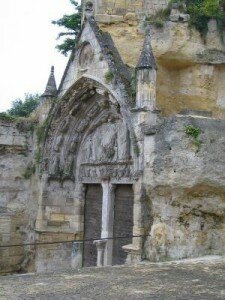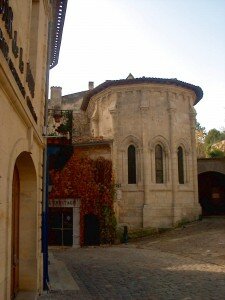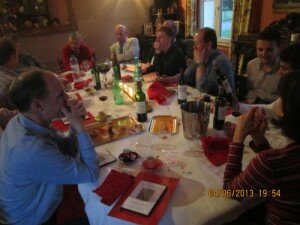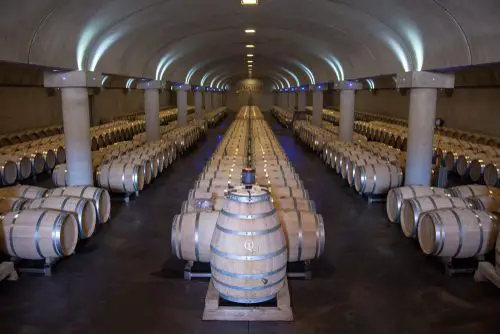 Paul Smith, our Financial Director, has been on a mission in Bordeaux to discover new wines, chateaux and wine makers. This is thesixth in a series of blogs about his trip and his discoveries.
Paul Smith, our Financial Director, has been on a mission in Bordeaux to discover new wines, chateaux and wine makers. This is thesixth in a series of blogs about his trip and his discoveries.
 The whole town is a UNESCO World Heritage site and sits perched high up on a limestone rock in the shape of an amphitheatre . Beneath your feet the streets are riddled with catacombs (173 acres of them!) that run deep underground.
The whole town is a UNESCO World Heritage site and sits perched high up on a limestone rock in the shape of an amphitheatre . Beneath your feet the streets are riddled with catacombs (173 acres of them!) that run deep underground.
They were once part of ancient quarries but nowadays they house wine cellars and labyrinth like tunnels which link up the old buildings above.Visiting Saint Emilion is like walking into a living museum, with each step you make taking you on a journey back in time.
 The town is named after the 8th century Breton monk Emilian who had a hermitage there. Emilian came to Ascumbas (the ancient Roman name for the town), chose a cave as a refuge and dug it out in the shape of a cross.
The town is named after the 8th century Breton monk Emilian who had a hermitage there. Emilian came to Ascumbas (the ancient Roman name for the town), chose a cave as a refuge and dug it out in the shape of a cross.
During his 17 years at the hermitage he is said to have performed many miracles and he built up a following of Benedictine monks who later built the 12th century subterranean Monolithic Church.
 I was introduced to the wines of Chateau Laniote during my trip to Bordeaux and its label has a picture of the chapel on it.
I was introduced to the wines of Chateau Laniote during my trip to Bordeaux and its label has a picture of the chapel on it.
The chateau also produces a Second Wine named after the chapel, Chapelle de Laniote.Emilian’s underground hermitage in the catacombs has been a national monument since 1889 and the holy site is protected by the 13th century Chapel of the Trinity which stands over it.
You can still visit Emilian’s hermitage, the chapel and catacombs . . . which strangely enough turn out to be owned by the family of Chateau Laniote, who rent them out to the local Tourist Office.
 Laniote is a Saint Emilion Grand Cru Classé. Grand Cru Classés are awarded every 10 years are so in the Saint Emilion Classification and Laniote has been a ‘GCC’ since 1955.
Laniote is a Saint Emilion Grand Cru Classé. Grand Cru Classés are awarded every 10 years are so in the Saint Emilion Classification and Laniote has been a ‘GCC’ since 1955.
To merit this rank wines have to undergo a set of rigid qualifications and are also examined for their consistency and typicity to make sure they represent the quality expected of such a rank.
The fact that the Saint Emilion Classification is reassessed every decade means that the quality is kept up to date, unlike other Bordeaux classifications.
 Laniote has been in the same family for 2 centuries and has been passed from mother to daughter down the female line for 7 generations. It began life in 1816 when Pierre Lacoste (1794 – 1862), a wine merchant from an old Saint Emilion family planted a few rows of vines at the old domaine of La Niotte.
Laniote has been in the same family for 2 centuries and has been passed from mother to daughter down the female line for 7 generations. It began life in 1816 when Pierre Lacoste (1794 – 1862), a wine merchant from an old Saint Emilion family planted a few rows of vines at the old domaine of La Niotte.
By 1844 the vineyard had been enlarged to its current size (12 acres) and a small chateau built. By 1874 ‘La Niotte’s’ wines had made a name for themselves and were noted in the wine directory Cocks & Feret.
The vineyards are planted with 80% Merlot, 15% Cabernet Franc and 5% Cabernet Sauvignon and lie on Asteries limestone (one of the hardest limestone rocks containing starfish type fossils that give its name).
Pascal himself came from a famous family of oenologists – his father, Jean, created the Bordeaux Institute of Oenology in 1949 and worked with the legendary Emile Peynaud.
Pascal’s great grandfather, Ulysse, worked as Louis Pasteur’s assistant in the late 19th century (Pasteur is well known for his discoveries of the first vaccinations for rabies and anthrax, microbal fermentation and pasteurization), and then moved to Bordeaux, where he was instrumental in perfecting the copper mixture used to fight downy mildew (known as ‘Bordeaux Mixture’).
Today Laniote is owned by Pierre Lacoste’s descendant Arnaud Varailhon de la Filolie, his oenologist wife Florence Ribéreau-Gayon and their children.
Oenology is the scientific study of wine and Florence is the niece of Pascal Ribéreau-Gayon, one of the world’s most prominent oenologists. He wielded tremendous influence during his lifetime and his students included some of the flying wine makers of today – including Michel Rolland and Denis Dubourdieu.
 As you can see Laniote has a fascinating background to it. Arnaud and Florence are a warm and welcoming couple and conduct wine tastings and tours at the chateau.
As you can see Laniote has a fascinating background to it. Arnaud and Florence are a warm and welcoming couple and conduct wine tastings and tours at the chateau.
Their enthusiasm for wine is infectious and Arnaud has a reputation for treating guests to a little magic as entertainment.
He is – amongst other things (a Baron, a winemaker and a gentleman) – a part time magician and treated us to a trick between each course at dinner! If you are ever in Bordeaux Laniote is well worth visiting and you can contact Arnaud and Florence here to make a reservation.

